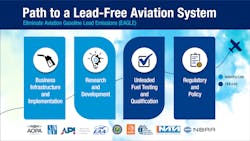EAGLE Stakeholders Convene First Meeting, Seek Solution to Leaded Fuel
The first stakeholder meeting of the Eliminate Aviation Gasoline Lead Emissions (EAGLE) initiative was held this week. The two-day event was attended by fuel refiners, distributors, engine OEMs, airplane manufactures and others.
The EAGLE initiative was announced in February with the goal of making general aviation (GA) lead-free by 2030 and finding a replacement for 100 low lead (100LL) fuel, with four guiding pillars behind it. EAGLE is a continuation of the Piston Aviation Fuels Initiative (PAFI) program, which it is not replacing, but utilizing lessons learned from and bringing in multi-industry stakeholders to solve the leaded fuel issue.
“The PAFI program is a key pillar to the success of this replacement of 100LL. One of things we highlighted in the meetings today and yesterday was the fact that there are so many other things that are effected other than just what is being done in the PAFI program,” explained Earl Lawrence, Executive Director of the FAA's aircraft certification service.
Spurring the EAGLE initiative and its multi-industry approach is the anticipated “endangerment finding” by the Environmental Protection Agency (EPA) on lead.
The EPA announced Jan. 12 that it will evaluate whether emissions from piston engine aircraft operating on leaded fuel contribute to air pollution that endangers public health and welfare. The agency plans to issue a proposal for public review and comment in 2022 and take final action in 2023.
Once this endangerment finding is issued, one of the fears is it could lead to the closing of airports.
“When the EPA comes out with a finding, which we believe they will in the not too distant future, that says ‘no amount of lead is safe’ … that is a real issue and they are right, we should move on. Some airports, notably in California, seem to be using this as an urgency to close airports,” said AOPA President and CEO Mark Baker.
With no drop-in substitute currently available, and unlikely to be found by the time of the EPA finding, the EAGLE initiative is a signal that the industry is working to solve the issue and airports need not be closed in the meantime.
“We have to have a safe way to maneuver these aircraft and we need that [100LL] fuel to support them. That’s why we can’t just stop selling them today,” Baker continued.
Baker pointed out there are numerous issues both in the aviation industry and outside of it compounding the problem of finding a replacement. Unlike how lead was removed from automotive gasoline, the engines of aircraft are fundamentally different, operating at fluctuating temperatures and altitudes, and require many different considerations– facilitating the need for a drop-in replacement.
“Why have we not gone unleaded so far? One of the big reasons is we have not found a, what we call, ‘drop-in replacement.’ And … there’s drop-in from a regulatory point and hardware standpoint and those two things have to go together,” said Lawrence.
The standards that have been used for decades for piston engines specifically required lead. The engines are designed to operate with lead and have to have a minimum amount of lead in the fuel to meet those specifications.
“So going to zero, from a legal standpoint, there’s not a direct replacement. So now, we have to do the studies that say, ‘Okay, legally it’s not a direct replacement, but will the engine run, will the airframe handle it, will the systems handle it?’ We learned a lot form PAFI and identified the things we need to be looking for when we make that transition,” Lawrence said.
As an example of the minutia needing consideration, Lawrence noted that vibration levels in an aircraft’s propeller are affected by fuel and the longevity of a propeller can change because of a fuel change.
“There are five candidates to replace 100LL, but they are not direct replacements. That’s our big challenge. When it’s not a direct replacement, how do replace it and what does it mean to not be a direct replacement because it’s a different answer for every candidate fuel,” continued Lawrence.
Another issue is trying to avoid replacing leaded fuel with something that is found to have another contaminant down the line.
“One of the discussions that is out there is, we could, from an FAA standpoint, certify a new fuel that may have a different contaminant in it. And so how do we have that conversation that we don’t replace one contaminant with another contaminant and have to have EAGLE 2 and another process to address those environmental concerns,” Lawrence said.
Further, many of the aircraft engines are more than 50 years old, with the average age of the fleet resting right at 50 years, and require a fuel to be compatible with aged equipment. A new fuel can’t erode the sealants in an engine from the 1950s, for example.
Outside of the aircraft specifications are issues such as, just because a hypothetical fuel could work in an engine doesn’t mean it can be refined or distributed, or that the EPA would approve it.
“Now we’re adding and bringing in the additional people and perspectives that we need to field a replacement,” said Lawrence of EAGLE’s goal.
As work continues towards the goal of a lead-free replacement for 100LL, another EAGLE stakeholder meeting is being planned for a date in the upcoming months.
About the Author
Walker Jaroch
Editor
Contact: Walker Jaroch
Editor | AMT
+1-920-568-8399
>> To download the AviationPros media kits, visit: Marketing Resource Center
>>Check out our aviation magazines: Ground Support Worldwide | Airport Business | Aircraft Maintenance Technology

